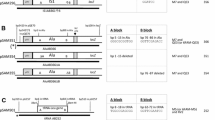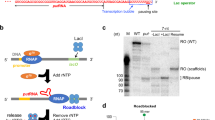Summary
Using a gel retardation assay, a protein factor that specifically interacts with a 33 by intragenic sequence of the highly expressed and glucose-inducible SRP1 gene of Saccharomyces cerevisiae has been detected. This binding site is located in a transcribed region and within the open reading frame (positions +710 to +743 relative to the first base of the initiation codon). A mutant strain carrying a deletion of this binding site showed a dramatic decrease in steady-state levels of SRP1 transcripts. This decline is not the result of a decrease in mRNA stability, since expression of hybrid genes in which the SRP1 promoter was replaced by the heterologous CYC1 promoter was not affected by the binding site deletion. These findings suggest that the 33 by sequence contains a cis-acting downstream activating element which is involved in the transcriptional activation of the SRP1 promoter. Sequence comparisons showed similarities between a site located within the 33 by sequence and the high-affinity consensus binding site of the RAP1/GRF1 (also named TUF) factor and methylation interference experiments confirmed that this site was involved in the protein-DNA interaction. Both the results of competition experiments with upstream activating sequences of ribosomal protein genes (UASrpg), which are targets for RAP1 binding, and determination of the apparent molecular weight of the affinity-purified DNA-binding protein indicated that RAP1 factor recognized the SRP1 33 by element. The 33 by sequence was found to be unable to provide UAS activity when placed upstream of the TATA box and transcription start site.
Similar content being viewed by others
References
Antoniou M, deBoer E, Habets G, Grosveld F (1988) The human β-globin gene contains multiple regulatory regions: identification of one promoter and two downstream enhancers. EMBO J 7:377–384
Boeke JD, Trueheart J, Natsoulis G, Fink GR (1987) 5-$uoroorotic acid as selective agent in yeast molecular genetics. Methods Enzymol 154:164–175
Brand AH, Micklem G, Nasmyth K (1987) A yeast silencer contains sequences that can promote autonomous plasmid replication and transcriptional activation. Cell 51:709–719
Buchman AR, Kimmerly WJ, Rhine J, Kornberg RD (1988a) Two DNA-binding factors recognize specific sequences at silencers, upstream activating sequences, autonomously replicating sequences and telomeres in Saccharomyces cerevisiae. Mol Cell Biol 8:210–225
Buchman AR, Lue NF, Kornberg RD (1988b) Connections between transcriptional activators, silencers, and telomeres as revealed by functional analysis of a yeast DNA-binding protein. Mol Cell Biol 8:5086–5099
Charnay P, Treisman R, Mellon P, Chad M, Axel R, Maniatis T (1984) Differences in human α- and β-globin genes. Expression in mouse erythroleukemia cells: the role of intragenic sequences. Cell 38:251–263
Chen CY, Oppermann H, Hitzeman RA (1984) Homologous versus heterologous gene expression in the yeast, Saccharomyces cerevisiae. Nucleic Acids Res 12:8951–8970
Evans MJ, Scarpulla RC (1988) Both upstream and intron sequence elements are required for elevated expression of the rat somatic cytochrome c gene in COS-1 cells. Mol Cell Biol 8:35–41
Feinberg AP, Vogelstein B (1984) A technique for radiolabeling DNA restriction endonuclease fragments to high specific activity. Anal Biochem 137:266–267
Fried M, Crothers DM (1981) Equilibria and kinetics of lac repressor-operator interactions by polyacrylamide gel electrophoresis. Nucleic Acids Res 9:6505–6525
Galson DL, Housman DE (1988) Detection of two tissue-specific DNA-binding proteins with affinity for sites in the mouse β-globin intervening sequence 2. Mol Cell Biol 8:381–392
Garner MM, Revzin A (1981) A gel electrophoresis method for quantifying the binding of proteins to specific DNA regions: application to components of the Escherichia coli lactose operon regulatory system. Nucleic Acids Res 9:3037–3060
Gillies SD, Morrison SL, Oi VT, Tonegawa S (1983) A tissue-specific transcription enhancer element is located in the major intron of a rearranged immunoglobulin heavy chain gene. Cell 33:717–728
Gilson TJ (1984) PhD thesis, University of Cambridge, UK
Guarente L (1983) Yeast promoters and lacZ fusions designed to study expression of cloned genes in yeast. Methods Enzymol 101:181–191
Guarente L (1988) UASs and enhancers: common mechanism of transcriptional activation in yeast and mammals. Cell 52:303–305
Guarente L, Hoar E (1984) Upstream activation sites of the CYC1 gene of Saccharomyces cerevisiae are active when inverted but not when placed downstream of the “TATA box”. Proc Natl Acad Sci USA 81:7860–7864
Guarente L, Ptashne M (1981) Fusion of Escherichia coli lacZ to the cytochrome c gene of Saccharomyces cerevisiae. Proc Natl Acad Sci USA 78:2199–2203
Hofman JFX, Laroche T, Brand AH, Gasser SM (1989) RAP-1 factor is necessary for DNA loop formation in vitro at the silent mating type locus HML. Cell 57:725–737
Huet J, Sentenac A (1987) TUF, the yeast DNA-binding factor specific for UASrpg upstream activating sequences: identification of the protein and its DNA-binding domain. Proc Natl Acad Sci USA 84:3648–3652
Huet J, Cottrelle P, Cool M, Vignais ML, Thiele D, Marck C, Buhler JM, Sentenac A, Fromageot P (1985) A general upstream binding factor for genes of the yeast translational apparatus. EMBO J 4:3539–3547
Ito H, Fukuda Y, Murata K, Kimura A (1983) Transformation of intact yeast cells treated with alkali cations. J Bacteriol 153:163–168
Kadonaga JT, Tjian R (1986) Affinity purification of sequence-specific DNA binding proteins. Proc Natl Acad Sci USA 83:5889–5893
Karpinski BA, Yang LH, Cacheris P, Morle GD, Leiden JM (1989) The first intron of the 4F2 heavy-chain gene contains a transcriptional enhancer element that binds multiple nuclear proteins. Mol Cell Biol 9:2588–2597
Kollias G, Hurst J, deBoer E, Grosveld F (1987) The human β-globin gene contains a downstream developmental specific enhancer. Nucleic Acids Res 15:5739–5747
Koltunow AM, Greggs K, Rogers GE (1987) Promoter efficiency depends upon intragenic sequences. Nucleic Acids Res 15:7795–7807
Maniatis T, Fritsch EF, Sambrook J (1982) Molecular cloning: A laboratory manual. Cold Spring Harbor Laboratory Press, Cold Spring Harbor, New York
Marguet D, Lauquin GJM (1986) The yeast SRP gene: positive modulation by glucose of its transcriptional expression. Biochem Biophys Res Commun 138:297–303
Marguet D, Fantino E, Lauquin GJM (1988a) Gene cloning from yeast chromosome-specific mini-library. Isolation of the SRP1related sequence located on chromosome XV. FEBS Lett 234:421–425
Marguet D, Guo XJ, Lauquin GJM (1988b) Yeast gene SRP1 (serine-rich protein). Intragenic repeat structure and identification of a family of SRP1-related DNA sequences. J Mol Biol 202:455–470
Maxam AM, Gilbert W (1980) Sequencing end-labeled DNA with base specific chemical cleavages. Methods Enzymol 65:499–560
Mellor J, Dobson MJ, Roberts NA, Kingsman AJ, Kingsman SM (1985) Factors affecting heterologous gene expression in Saccharomyces cerevisiae. Gene 33:215–226
Mellor J, Dobson MJ, Kingsman AJ, Kingsman SM (1987) A transcriptional activator is located in the coding region of the yeast PGK gene. Nucleic Acids Res 15:6243–6259
Nieuwint RTM, Mager WH, Maurer KCT, Planta RJ (1989) Mutational analysis of the upstream activation site of yeast ribosomal protein genes. Curr Genet 15:247–251
Osborne TF, Arvidson DN, Tyau ES, Dunsworth-Browne M, Berk AJ (1984) Transcription control region within the protein coding portion of Adenovirus E1A genes. Mol Cell Biol 4:1293–1305
Purvis IJ, Loughlin L, Bettany AJ, Brown AJP (1987) Translation and stability of an Escherichia coli β-galactosidase mRNA expressed under the control of pyruvate kinase sequences in Saccharomyces cerevisiae. Nucleic Acids Res 15:7963–7974
Queen C, Baltimor D (1983) Immunoglobulin gene transcription is activated by downstream sequence elements. Cell 33:741–748
Rosenfeld PJ, Kelly TJ (1986) Purification of nuclear factor I by DNA recognition site affinity chromatography. J Biol Chem 261:1398–1408
Rossi P, de Crombrugghe B (1987) Identification of cell-specific transcriptional enhancer in the first intron of the mouse a2 (type I) collagen gene. Proc Natl Acad Sci USA 84:5590–5594
Rotenberg MO, Woolford JL (1986) Tripartite upstream promoter element essential for expression of Saccharomyces cerevisiae ribosomal protein genes. Mol Cell Biol 6:674–687
Rothstein RJ (1983) One-step gene disruption in yeast. Methods Enzymol 101:202–211
Sentenac A, Hall B (1982) Yeast nuclear RNA polymerases and their roles in transcription. In: Strathern JW, Jones EW, Broach JR (eds) The molecular biology of the yeast Saccharomyces cerevisiae, vol 2. Cold Spring Harbor Laboratory Press, Cold Spring Harbor, New York, pp 561–606
Shaul Y, Rutter WJ, Laub O (1985) A human hepatitis B viral enhancer. EMBO J 4:427–430
Sherman F, Fink GR, Lawrence CW (1974) Methods in yeast genetics (revised 1983). Cold Spring Harbor Laboratory Press Cold Spring Harbor, New York
Shore D, Nasmyth K (1987) Purification and cloning of a DNA-binding protein from yeast that binds to both silencer and activator elements. Cell 51:721–732
Snyder M, Davis RW (1988) SPA1: a gene important for chromosome segregation and other mitotic functions in S. cerevisiae. Cell 54:743–754
Stanway CA, Chambairs A, Kingsman AJ, Kingsman SM (1989) Characterization of the transcriptional potency of the sub-elements of the UAS of the yeast PGK gene in a PGK minipromoter. Nucleic Acids Res 17:9205–9218
Struhl K (1984) Genetic properties and chromatin structure of the yeast gal regulatory elements: an enhancer-like sequence. Proc Natl Acad Sci USA 81:7865–7869
Struhl K (1989) Molecular mechanisms of transcriptional regulation in yeast. Annu Rev Biochem 58:1051–1077
Vignais ML, Woudt LP, Wassenar GM, Mager WH, Sentenac A, Planta RJ (1987) Specific binding of TUF factor to upstream activation sites of yeast ribosomal protein genes. EMBO J 6:1451–1457
Vignais ML, Huet J, Buhler JM, Sentenac A (1990) Contacts between the TUF factor and RPG sequences. J Biol Chem 265:14669–14674
Wright S, Rosenthal A, Flavell R, Grosveld F (1984) DNA sequences required for regulated expression of β-globin genes in murine erythroleukemia cells. Cell 38:265–273
Yutzey KE, Kline RL, Konieczny SF (1989) An internal regulatory element controls troponin I gene expression. Mol Cell Biol 9:1397–1405
Zitomer RS, Hall BH (1976) Yeast cytochrome c messenger RNA. In vitro translation and specific immunoprecipitation of the CYC1 gene product. J Biol Chem 251:6320–6326
Zubenko GS, Jones EW (1982) Genetic properties of mutations at the PEP4 locus in Saccharomyces cerevisiae. Genetics 102:679–690
Author information
Authors and Affiliations
Additional information
Communicated by R. Devoret
Rights and permissions
About this article
Cite this article
Fantino, E., Marguet, D. & Lauquin, G.J.M. Downstream activating sequence within the coding region of a yeast gene: specific binding in vitro of RAP1 protein. Molec. Gen. Genet. 236, 65–75 (1992). https://doi.org/10.1007/BF00279644
Received:
Accepted:
Issue Date:
DOI: https://doi.org/10.1007/BF00279644




